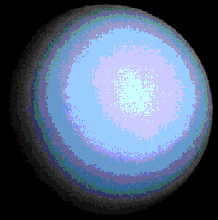This is an image of Uranus.
Click on image for full size
NASA
An Overview of Uranus' Atmosphere
The bland aquamarine face of Uranus bears witness to the fact that Uranus is enshrouded in clouds. The planet appears to be blue-green because the atmosphere absorbs the red wavelengths of the visible spectrum . The uniformity of the planet's appearance confirms that the planet's atmosphere is composed almost solely of one element, methane gas. There is a preponderance of haze, composed of ethane and other hydrocarbon ices high in the stratosphere, and clouds of methane ice low in the troposphere. The cloud particles constantly recycle themselves, first creating then destroying the heaviest crystals. This is an indication that Uranus' atmosphere is still evolving from its formation out of the solar nebula. Because Uranus lies on its side, Uranus has very strange seasons. Motions in the cloud patterns indicate that, like Jupiter and Saturn, the basic meteorology of Uranus can be described as a striped pattern of winds. This means that, even though the pattern is difficult to distinquish, Uranus is striped, just like Jupiter and Saturn.
You might also be interested in:
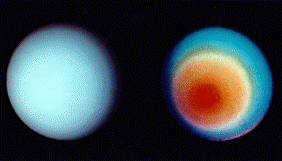
The clouds of Uranus, composed of methane crystals, are found very low in the troposphere, and are difficult to distinquish below the smog haz es of the planet's atmosphere. False color is used, in the
...more
As on Earth, the atmosphere of Uranus consists of a troposphere, stratosphere, mesosphere, and thermosphere. The troposphere is the region where the visible clouds are to be found. The stratosphere, as
...more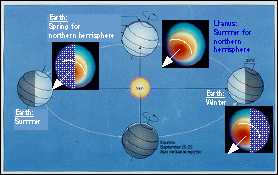
As a planet orbits the sun, if its rotation axis is tilted, the portion that is tilted toward the sun will receive an excess of sunlight and energy (summer), while the hemisphere which is tilted away
...more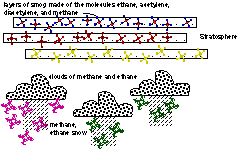
Besides methane, Uranus' atmosphere contains more sophisticated atmospheric molecules such as ethane gas, acetylene, and diacetylene. All these molecules form layers of haze at different altitudes high
...more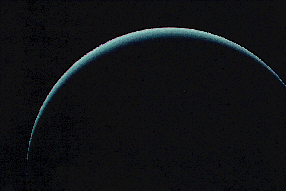
The mesosphere of Uranus is a region of balance between warming and cooling. That essentially means that nothing happens there. Except for diffusion, the atmosphere is still. Upper reaches of the atmosphere,
...more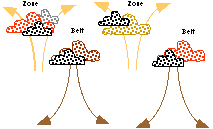
On Uranus, as on Jupiter, the winds in the belts and zones blow first in one direction, then in the opposite direction. Wind blows east in a belt, and west in a zone. The clouds rise up in a belt, and
...more
The striped cloud bands on Uranus, like Jupiter, are divided into belts and zones. On Uranus the belts and zones are hard to distinquish. The left picture shows the north pole of Uranus. In this picture
...more


